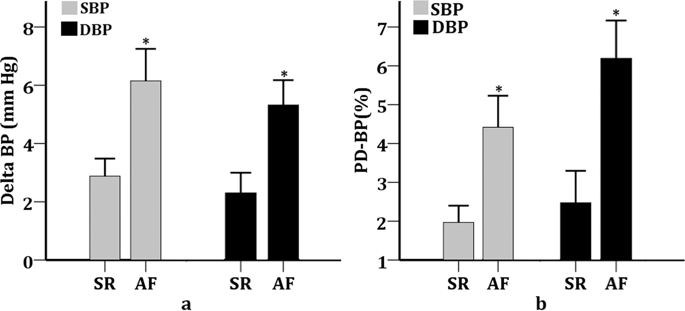Hypertension Research ( IF 4.3 ) Pub Date : 2020-01-10 , DOI: 10.1038/s41440-019-0386-4 Feng Xie 1 , Jingsong Xu 1 , Ling-Lin Xia 2 , Xiao Luo 1 , Zhenzhen Jiang 1 , Yanqing Wu 1 , Hai Su 1

|
This study evaluated the impact of ventricular rate (VR) in atrial fibrillation (AF) patients with oscillometric BP measurements. This study included 138 patients with AF and 112 patients with sinus rhythm (SR) who underwent coronary angiography. Left arm BP was measured three times with an oscillometric device, and the average was recorded as the final oscillometric value. At the same time, the average of three intra-aortic BP readings was used as invasive values. Delta BP was the difference between intra-aortic and oscillometric BP. Meanwhile, the BP percentage difference (PD-BP) was calculated with the following formula: PD-BP = (delta BP/intra-aortic BP) × 100%. Based on the VR, four subgroups of AF and SR patients, <80, 80–99, 100–120, and >120 bpm, were created, and the mean PD-BP for both systolic blood pressure (SBP) and diastolic blood pressure (DBP) was significantly higher in the AF group than in the SR group. Moreover, the mean PD-SBP values gradually increased as VR increased in both groups. More importantly, the difference in PD-SBP between the AF and SR groups increased as VR increased: when VR was <80 bpm, the levels were similar (−2.0 ± 3.5 vs. −1.4 ± 2.7 mm Hg, NS), but these values in AF patients were significantly higher when VR was 80–99 bpm (−3.7 ± 5.0 vs. −1.8 ± 2.3 mm Hg, p < 0.05), 100–120 bpm (−6.1 ± 4.3 vs. −2.3 ± 1.9 mm Hg, p < 0.05) and >120 bpm (−7.8 ± 4.9 vs. −2.9 ± 1.7 mm Hg, p < 0.05). The accuracy of oscillometric BP measurements are dependent on the ventricular rate in AF patients even after three measurements, and a higher ventricular rate may result in larger underestimations of oscillometric BP.
中文翻译:

心房颤动对示波血压测量准确性的影响:心室率的影响
本研究通过示波血压测量评估了心房颤动 (AF) 患者心室率 (VR) 的影响。这项研究包括 138 名 AF 患者和 112 名接受冠状动脉造影的窦性心律 (SR) 患者。左臂血压用示波仪测量3次,取平均值作为最终示波值。同时,使用三个主动脉内血压读数的平均值作为有创值。Delta BP 是主动脉内血压和示波血压之间的差异。同时,使用以下公式计算BP百分比差异(PD-BP):PD-BP =(delta BP /主动脉内BP)×100%。基于 VR,创建了 AF 和 SR 患者的四个亚组,<80、80-99、100-120 和 >120 bpm,AF 组的收缩压 (SBP) 和舒张压 (DBP) 的平均 PD-BP 显着高于 SR 组。此外,随着 VR 的增加,两组的平均 PD-SBP 值逐渐增加。更重要的是,AF 组和 SR 组之间的 PD-SBP 差异随着 VR 的增加而增加:当 VR <80 bpm 时,水平相似(-2.0 ± 3.5 vs. -1.4 ± 2.7 mm Hg,NS),但这些当 VR 为 80-99 bpm(-3.7 ± 5.0 vs. -1.8 ± 2.3 mm Hg,p < 0.05)、100–120 bpm (-6.1 ± 4.3 vs. -2.3 ± 1.9 mm Hg, p < 0.05) 和 >120 bpm (-7.8 ± 4.9 vs. -2.9 ± 1.7 mm Hg, p < 0.05)。示波 BP 测量的准确性取决于 AF 患者的心室率,即使在 3 次测量后也是如此,较高的心室率可能会导致对示波 BP 的更大低估。











































 京公网安备 11010802027423号
京公网安备 11010802027423号